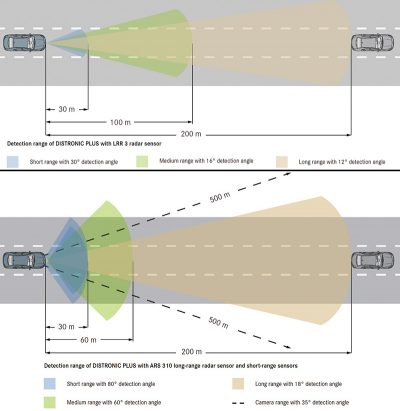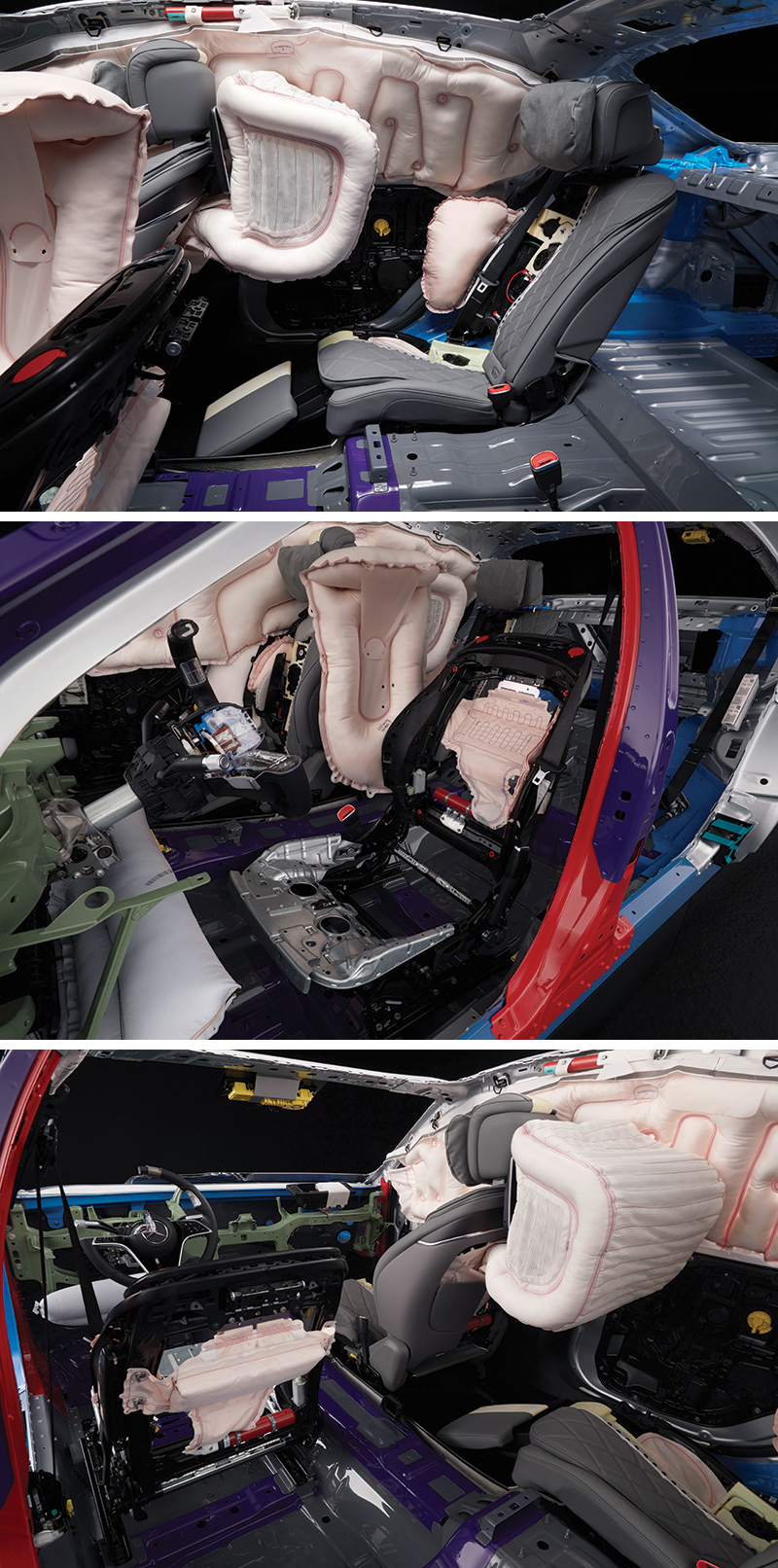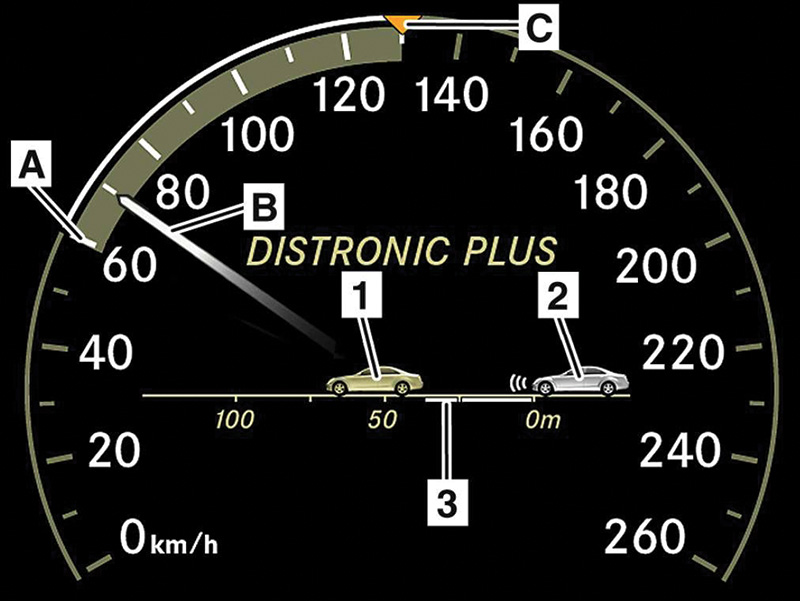Technology Advancements and Avoiding Service Snafus
The Mercedes-Benz PRE-SAFE system was originally conceived as an engineering concept for a driver assistance system rooted in collision prevention and mitigation. The PRE-SAFE system was taken from an innovative concept, to the Paris Auto show in 2002, to its first real-world production deployment in the 2003 model 220 S-Class. The system (to the author’s knowledge) is a first-of-its-kind application of multiple networked vehicle systems working in concert to provide occupant protection and impact damage mitigation before the crash.
Early PRE-SAFE models’ features included tensioning the seat belts, closing door windows and preparing the chassis and occupants for impact. Now, PRE-SAFE involves nearly every major vehicle system, surrounding the occupants with incredible levels of safety and dynamic vehicle stability.
In the subsequent years, the PRE-SAFE concept has morphed into a multi-system symphony of sensors communicating on multiple networks, system output devices, and control modules all designed with the original concept of PRE-SAFE in mind: collision prevention and impact mitigation.
Starting in 2006, Mercedes-Benz introduced one of its first steps toward autonomous vehicle controls with the addition of the Brake Assist PLUS system. This innovative technology uses brake speed and force measurements, radar returns and other inputs to sense, process and command an assist to the power brakes in the event the system determines an impending crash, or in a panic stop situation. In fact, the BAS PLUS system can even help prevent a crash from even happening.
Today’s PRE-SAFE concept is no longer limited to seat belts and BAS, but has been transmogrified into a cacophony of multiple systems, including engine, transmission, SRS, ABS/ESP, steering control, instrument cluster, body control and gateway. Long-, medium- and short-range radar sensor nodes (which include the radar sensor, processor and CAN node in one module), proximity sensors and cameras are in play. The technology utilizes modules that operate on six separate CAN or FlexRay networks and a LIN network.
First, consider the sheer volume of input data, output control and communication that must occur seamlessly to get a visual picture of the “symphony of signals†to which we refer. Then, consider that these signals are sensed, analyzed, run through truth tables and algorithms, then CAN or FlexRay messages are configured and sent to the reacting output device(s) via control module data transfer. This entire process occurs in millionths of a second.

The Progression of PRE-SAFE Technology
So let’s take a dive into the progression of PRE-SAFE technology. The best way to understand this is to follow the progression of technological upgrades on a single model, in this case the S-Class since PRE-SAFE started with the S-Class.
W221 Chassis Advancements
We start with the 2006 W221 S-Class because, for the most part, this model year is where the technology really starts ramping up big-time. The Mercedes-Benz engineering team took things to a whole new level with the addition of BAS Plus, DISTRONIC Plus and Park Assistant (option code 233). This option package is one of the first multi-system ADAS (Advanced Driver Assistance System) packages in the industry, and with it a new generation of smart automotive technology was born.
PRE-SAFE Brake, Mercedes-Benz’ Collision Mitigation System (CMS), prepares the passengers and vehicle for an impending collision by pre-tensioning the seat belts, closing the windows and adjusting the front passenger seat as well as providing autonomous emergency braking.
DISTRONIC PLUS with BAS PLUS
The BAS PLUS system is the next evolution of assisted braking. The system uses brake force calculations and other dynamic vehicle inputs to provide precisely the correct amount of braking assist for the amount of brake force being applied by the driver. In the event that there is no input from the driver, when the DISTRONIC PLUS radars, cameras and sensors detect that a crash is imminent, the system will apply between 40 and 60% braking force to the wheels to help mitigate a crash. BAS PLUS works in concert with several other systems as well.
DISTRONIC PLUS, aka DISTRONIC on Steroids

This system technology upgrade adds short and mid-range radar to supplement the long range radar of the original DISTRONIC, so PLUS just adds the short and medium-range radars. The two radar detection angle images (right) show how these radar sensors (both early and later versions) operate over various ranges and angles.
The driver has the option to set the following distance to the vehicle ahead, using the left and right steering wheel controls and watching the distance indicator on the cluster. When the system detects a vehicle slowing down or speeding up ahead, the system is designed to automatically brake or accelerate (up to the maximum speed set by the driver) to maintain a safe following distance. If the system detects a vehicle ahead stopping suddenly, the system senses an impending collision and takes action: A warning is displayed in the instrument cluster, a tone sounds and, if necessary, emergency braking is commanded as PRE-SAFE prepares the occupants and vehicle.
The S-Class also incorporates several other driver assist functions, including a distance warning system and, on later models, an active distance warning system. This is integrated into DISTRONIC PLUS and also includes Park Assist, which uses proximity sensors to provide visual parking distance assistance on the instrument cluster and the rear headliner. The Advanced Parking Guidance (APG) system assists the driver in finding a sufficiently sized parking spot but, on this model, the driver must then physically park the vehicle in the slot themselves.
Blind Spot Monitoring is included as well. This system’s blind spot sensors also feed data into the overall ADAS scheme by providing data regarding objects or traffic at the sides and rear of the vehicle. The system throws this data in the mix with the cameras, radars and sonic proximity sensors to provide a more complete “total picture.â€
A Night View Assist (NV) option was also offered on the 221 chassis and uses infrared light-based emitters and camera systems to detect pedestrians, animals and wildlife using reflected infrared light. Adaptive High Beam Assist uses camera-based light sensing and automatically adjusts the range of the low beam headlamps to the distance of detected vehicles which are in front of or coming towards the vehicle. The optimal headlamp range of up to about 1000 feet is thus made available to the driver if it won’t dazzle another driver.
222 Chassis Advancements
The 222 chassis, built from 2014 to 2020, boasts even more PRE-SAFE related advancements. On the 222, we see the following additions and upgrades:
- DISTRONIC PLUS continues in the 222 as option code 233 until the mid-model run addition of Steer Assist, (DTR+Q). The +Q designation adds electric steering assist to the DISTRONIC PLUS system.
- Active Blind Spot Assist (BSM+) watches the sides and rear, and can intervene to help avoid a collision.
- Night View Assist PLUS (NV+) enhances the infrared signature and highlights the danger on the screen. This helps quickly identify the location of that deer before it runs out from the roadside.
223 Chassis Advancements
The all-new model 223 seventh-generation S-Class takes PRE-SAFE to a stratospheric technological level. Additions to the DTR+Q system include:
- Rear collision warning system if equipped with the Driving Assistance Package. This includes a new, medium-speed radar unit in the back to detect potential rear collisions.
- PRE-SAFE Occupant Side Collision Protection. This innovative feature, in addition to prepping the seat belts, door and sunroof windows, deploys air bags in the seats to quickly force the occupant inward toward the center of the vehicle to help mitigate potential injury from a side impact.
- The reversible seat belt system works in conjunction with this feature, reducing tension on the seat belts restraining the passengers seated opposite the side of the impact.
These last two features actually re-position the occupant, but also counteract the physical forces applied to the body by suddenly accelerating the occupant in the direction of the impact, thereby reducing the physical forces absorbed by the body during the impact. The nearby photos will help explain the extent of this system.

The Mercedes-Benz model 223 S-Class with driver assist feature and electro-hydraulic suspension can instantly raise the body of the vehicle by about 8 cm just milliseconds before impact, directing side-impact collision forces downward toward the lower door and frame area and away from the occupant’s proximity to the door.
This is Star Trek stuff on four wheels, folks. And as techs, we’ve got to be able to sort them out professionally and cost effectively when the various systems might be feeling a bit tipsy, such as in the case of an intermittent communications fault. There are so many high-tech upgrades to the PRE-SAFE, DISTRONIC PLUS and Driver Assistance Systems in the new 223, again, it would simply be impossible to list and explain them all here and do the information justice.
So, with all of this quantum-leap computing technology, let’s consider some service, repair and diagnostic thoughts:
When a customer comes in with a strange complaint, a common one for us is “my car keeps forcefully braking itself for no reason from time to time.†Another common complaint is: “My cruise control just suddenly stops working and I get a warning message on the dash, yet five minutes later, it is working fine.†What could create such issues, when the vehicle otherwise exhibits no DTCs or other causal symptoms?
And why does it seem we are rarely able to duplicate the condition?
To answer these questions, the best technicians learn to work with the service advisor to really drill down into the customer complaint and discuss with the advisor or customer the possibility that some of the system’s limitations may be at play. Mercedes-Benz service information does a great job of warning us about these system limitations and what may happen in certain driving situations.
The first diagnostic warning for technicians about these systems relates to low voltage issues. A low voltage issue in any module can and will cause communication errors, motor and actuator functional issues, along with control unit resets and a host of other “glitch†conditions.
Mercedes-Benz does a fabulous job with the engineering of their quiescent (at-rest) power management. A strong recommendation is to first track down any voltage- or current-related codes, check for excessive current consumers and check battery state-of-health and power management logs. Solve communication faults next, in your general strategy. Fix any voltage related DTCs first though, because this can be a major source of communication faults and DTCs.
After addressing voltage- and communication-related faults, you may find that your circuit and component related DTCs do not reappear. This thought is often missed while chasing specific DTCs, and should be considered in your overall diagnostic strategy.
There are many function triggers from the various interconnected systems that will instruct the PRE-SAFE system to apply warnings and prepare the system for a crash. Vehicle speed characteristics for example, radar and sensor feedback, deceleration rates, panic braking forces, steering angle and force inputs, all of these and many more can “trigger†some combination of vehicle and occupant prep for the crash. Was that Steering Angle Sensor relearned properly?
A conscientious technician must read circuit description and operation material, and understand these triggers in order to accurately pinpoint the fault. Additionally, pay attention to the individual system’s disclaimers regarding operation in weather or dirty, muddy, snowy or other adverse conditions. For example, in the 221 models Mercedes-Benz Service Information specifically warns that the cameras, radar units or sensors can be dirty, damaged, out of calibration or otherwise physically obstructed to the point that the software decides to disable the system and return control to the driver. There are numbers of things even on clear sunny days that can cause the system to hand control back to the driver, including sun glare or reflection glare that blind the cameras on a perfectly beautiful day.
Another thing that can trip up any ADAS system is no visible lane markings or lines on the road surface. On these roads, the ADAS systems will typically become disabled or unavailable when the system cannot identify the proper lane positioning. A light covering of leaves or snow is enough to obscure the lane markings.
NOTE: An important diagnostic service information warning: all DISTRONIC-type systems (by law) must automatically shut down around any radio astronomy or other sites where interference from the vehicle’s radar may disrupt critical communications. Pay attention to this one, it’s a sleeper, and not often considered in the diagnostic. This has even happened to me in my own car! The GPS system is used to determine when the vehicle is passing through these areas.
Also beware of high-resistance corrosion in wiring, contact pin drag tension issues, interference from other RF (radio frequency) systems, communication data line termination and wiring problems and, of course, cars doing weird things because of mis-calibrated cameras and radars, hardware and software faults. Pay particular attention to recalibration if the vehicle has recently visited a body shop, where they might not be aware that ‘no MILs lit’ doesn’t mean all is OK. I jokingly call this the ‘Animal Factor.’
The Animal Factor is a term I coined (but don’t use) to refer to someone slam-banging through a flat rate job and not paying attention to instructions or details. The Animal Factor is in play in a huge way when it comes to not calibrating modules and components, post-repair on all vehicles with this technology. This is in my opinion one of the most prolific problems in the ADAS world today, next to communications issues. Let me explain why:
A keynote speaker at a major industry event last year, an engineer from an ADAS system controller and software company told us in his speech that a simple two degree offset of a front radar unit or camera’s calibration can result in that radar reading off-target by over 150 feet out at the radar’s maximum range. When a customer complains of the vehicle doing weird things, consider what can happen if the radar is reading traffic 150 feet to the left or right of where it should be looking.
One of the most ignored warnings issued by Mercedes-Benz (and all manufacturers of ADAS systems) is that the system absolutely must be calibrated if and when related parts are replaced, or the front or rear suspension is modified in any way. Let us define modified: Not only does this mean we need to recalibrate if one were to ‘upgrade’ the tires or suspension components, but modified also refers to alignment of the suspension (i.e., wheel alignment).
This instruction warning applies to the camera, radar and other devices. Just due to the sheer liability involved, shop technicians must heed and follow these warnings and post-repair instructions to the letter. The Animal Factor is alive and well in our industry, we must not be animals when repairing these vehicles!
Bear in mind there are probably tens or even hundreds of thousands of vehicles out there right now that have been ‘aligned’ at tire stores, shops and, yes, even dealerships without systems being properly re-calibrated. It happens every day. In several of our support cases regarding ADAS complaints over the last year, this has been found to have been the root cause of the customer complaint. Note that Mercedes-Benz USA requires technicians to document on the repair order the system realignment or calibration whenever a job calls for it.
In summary, when servicing any Mercedes-Benz PRE-SAFE equipped vehicle, please either invest in the equipment needed to perform these functions, or for heaven’s sake and your customer’s sake, get the vehicle over to the local Mercedes-Benz dealership or licensed XENTRY specialist for proper calibration. Lives can depend on it.
Remember to decipher customer complaints, listen, learn, do your best to understand the theory and don’t be afraid try new methodology in your testing when dealing with Advanced Driver Assist System complaints. Good luck, and happy diagnosing! Until next time, enjoy the upcoming springtime!







0 Comments